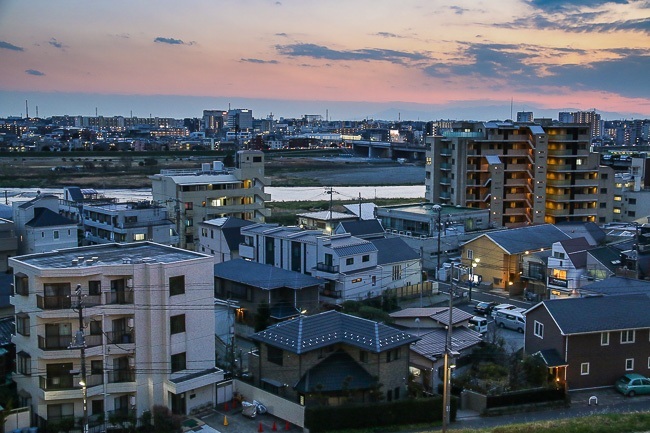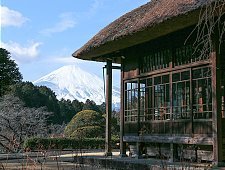Escaping to the roofs in Tamagawa

Deciding that I needed a little escapade before the rush of the cherry blossom season, I headed to an area in western Tokyo known as Tamagawa. The area is not a major tourist area unlike some of the more popular districts like Shinjuku, Shibuya and Akihabara, but still manages to be an extremely trendy and fashionable district. The main train station to access the Tamagawa area is Futakotamagawa Station, about ten minutes from Shibuya Station.
The Tamagawa area is separated from Kanagawa Prefecture by the Tamagawa River. There are four main rivers that flow through the metropolis that is Tokyo, namely the Tamagawa River in the western end, and moving east wards, the Sumidagawa River, the Arakawa River and the Edogawa River. Cities near the rivers tend to have lots of greenery and wide open spaces, except for the Sumidagawa River which is quite densely populated on both sides. I am happy to report that the Tamagawa district is a healthy mix of both greenery and urban landscape.


An interesting thing that I learnt was, because of their Tokyo address, rental properties in Tamagawa are typical of Tokyo: small with high prices. But just a few hundred meters across the river near Futako-shinchi Station in Kanagawa Prefecture, rental prices are almost halved and floor space a lot larger! Add to that, barbecues are not allowed along the riverside on the Tokyo side but are perfectly fine on the Kanagawa side. Goes to show that it's not the location that makes all the difference but the address.
The Tamagawa area is visibly affluent once you step out from Futakotamagawa Station. Expect to see lots of big, expensive cars on narrow streets, high-end boutiques and pretty walkways. Visitors were a mixed crowd of young families, stylish young people and dandy older folks. Everyone was fashionably chic, even the older folk, as expected of a trendy Tokyo district. It seems that the area is also a place for celebrity spotting, but I didn't spot any when I was there.

I started my day at the Takashimaya department store which is made up of several buildings and seemed to carry a lot contemporary and upmarket brands compared to the one in Shinjuku. Of interest is the roof top garden which connects two of the main Takashimaya buildings closest to the station. Despite the cold and crisp winter air, the roof was relatively crowded with families near the kids play area, while others sat around the tables and chairs in the garden. I expect it to be even more popular during the warmer months.


Across the road from the two main buildings is Marronier Court which was given a facelift by acclaimed Japanese architect Kuma Kengo and opened in 2015. The three story building houses only a handful of shops, with Muji as the main anchor. Directly across from Marronier Court is Japan's largest Ron Herman store, a Californian clothing and lifestyle brand. It is not easy to miss the building as its front is completely covered in ivy. Of interest to me - more than the shopping - was the cafe on the roof. It can be a convenient spot in the main shopping strip when everywhere seems to be crowded. I imagine some people hanging out at the cafe terrace like it's their secret spot (I know would if I lived closer!)





While many of the things to see and do are close to the station, I went for a walk along the riverside to take in some fresh air and watch learner drivers go through their paces at one of the few driving centers in Tokyo, before finding myself at a rundown-looking cafe disguised as a warehouse covered in corrugated metal. The outside of the cafe is definitely instagram-worthy for the hip and young clientele that frequent the place. In fact, despite being a distance away from the station, the cafe was full and the waiting crowd spilled to the deck outside.




Having filled my stomach with delicious food (the cafe wasn't just a good looker), I headed over to the ginormous Futako Tamagawa Rise. Completed in 2015, the site covers a large area of almost a kilometer length wise and is like a city within a city. In addition to shopping, there is also an IMAX cinema, the Rakuten Crimson House office building (which supposedly offers great views of the city), residential apartments and a large park overlooking the river. All the above mentioned amenities are connected by a meandering gentle walkway, which also serves as a transition from city to nature.
One of my favourite part of the complex was heading up to the roof area (yet again!), and looking down at the mini city below and the sunset before my eyes. Perhaps the wintry winds were a deterrent for many to head up to the roof, but I enjoyed the quietness and stillness of the city from there. But it was not long before my numb face and fingers needed some defrosting and I headed back indoors to warm up.






Tsutaya Electrics is one of the brands of Tsutaya bookstore and lifestyle company. Fans would recognise the brand from the T-Site in Daikanyama and Hirakata, the Tsutaya Bookstore in Naka Meguro and Tsutaya Tokyo Roppongi, all opened by the same company. There are currently only two Tsutaya Electric stores in all of Japan, one at Futako Tamagawa Rise and the other by Hiroshima Station. The concept is similar to the bookstores with the addition of home electronic goods.
I ended my a day of modern buildings with a sitdown at a cafe in the Tsutaya store, keeping warm and reading up on the latest trends. Being only ten minutes away from Shibuya , the Tamagawa area is easily doable as an easy day trip out of central Tokyo. Perfect on the days when you sleep in, but still want to see something urban, something green, the best of both worlds, really.













